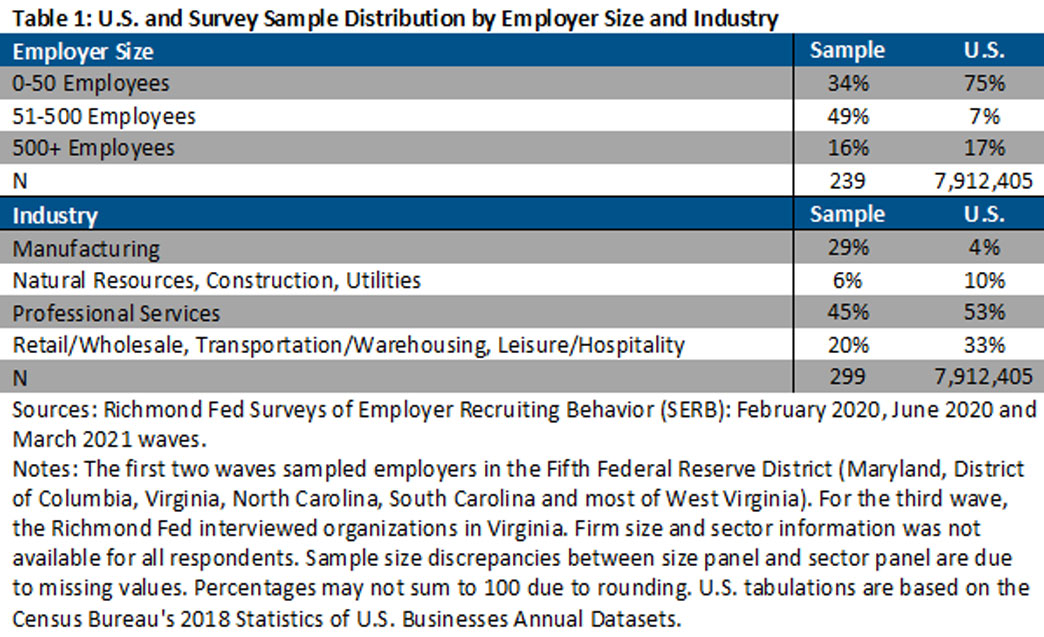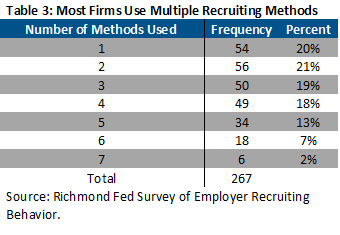How Do Employers Recruit New Workers?
While data on the number of job openings and hires are readily available, data on how hires happen are less so. The Richmond Fed surveyed employers around the Fifth Federal Reserve District to shed light on how employers recruit new workers. We find that recruiting for many jobs starts well before the 30-day window defined by the Job Openings and Labor Turnover Survey (JOLTS) for active vacancies, meaning those job openings may not be counted by JOLTS. We also note that referrals and recommendations are among the most popular methods for finding job candidates and explore why.
Standard sources of statistical information about U.S. labor markets report the number of hires and job openings but say little about how hiring happens. This leaves several important questions:
- What methods do employers use to recruit prospective employees?
- How do recruiting methods differ by employer size and industry?
- When do employers start recruiting to fill an open job position?
A few studies have shown that recruiting intensity per job opening matters greatly for the pace of hiring, but these studies also say little about how employers actually recruit workers.1
A better understanding of recruiting methods and the hiring process would be useful for several reasons. For one, methods that rely heavily on personal contacts and referral networks could disadvantage job seekers who are not tied into the relevant networks. For another, if initial job interviews now take place mostly online, job seekers who lack ready access to high-quality internet service could be disadvantaged. These concerns have become more acute, because the pandemic brought especially high rates of job loss for minorities, less-educated workers and those with low earnings.
Surveying Employers on Recruiting Methods
To throw new light on recruiting methods and the hiring process, the Federal Reserve Bank of Richmond sampled 308 employers across three survey waves:
- The February 2020 wave, which ran Jan. 31-Feb. 19 and asked respondents about recruiting efforts for the position their firm most recently filled or sought to fill in the prior 12 months
- The June 2020 wave, which ran May 28-June 17, covered the same topics as the February 2020 wave and also asked about the most recent position over the previous three months
- The March 2021 wave, which ran March 17-31 and asked about recruiting efforts for the typical open position in the last 12 months
We oversampled mid-size firms with 51-500 employees, undersampled smaller firms and oversampled manufacturing firms, as seen in Table 1.
Active Recruitment Often Begins Early
Many employers start recruiting for open positions long before they intend for someone to begin work. As shown in Table 2, 43 percent of employers in our sample began recruiting at least six weeks in advance of the desired start date, and 13 percent began recruiting 12 or more weeks in advance.
Also, 80 percent of respondents use at least two recruiting methods per open job, as seen in Table 3.
The idea here is that an employer cannot readily ascertain the true ability of a prospective new hire or the quality of a match. Someone who knows the candidate personally or is professionally trained to screen workers can supply valuable information.3 In fact, 31 percent of our respondents explicitly state that recommendations and referrals "save time/resources evaluating candidate quality."4
Another theory emphasizes monitoring problems in the presence of hidden actions. The idea is that employers cannot detect and punish all instances of bad conduct or bad performance on the job. Referrals and recommendations alleviate this concern when workers are responsive to potential punishments via the network. This can occur through the disappointment or anger of a recommender or through the unwillingness of the current employer to provide a positive recommendation to prospective future employers.5 About 30 percent of respondents declare that referrals and recommendations yield candidates who are "less likely to perform poorly" and/or "more likely to be trustworthy." This finding suggests that networks play an important role in encouraging strong worker performance.
Interestingly, 36 percent of respondents also indicate that network-based recruiting is excellent for "promotion of company and positions." This provides another potential reason for employers to participate in some recruiting activities, even when they do not have specific job openings.
Conclusion
The Richmond Fed's Survey of Employer Recruiting Behavior (SERB) aims to deepen our understanding of how firms recruit workers. Results thus far indicate that many employers start recruiting much more than 30 days before the desired start date for the new hire.
SERB data also highlight the prevalence of network-based recruiting: recommendations, referrals, partnerships with educational institutions, and intermediated hiring. Our evidence also indicates that network-based recruiting can lower hiring costs, yield recruits of higher quality and promote stronger employee performance.
Steven J. Davis is the William H. Abbott Distinguished Service Professor of International Business and Economics at the University of Chicago Booth School of Business. Claudia Macaluso is an economist and Sonya Ravindranath Waddell is a vice president and economist in the Research Department of the Federal Reserve Bank of Richmond.
These studies include the 2013 Quarterly Journal of Economics paper "The Establishment-Level Behavior of Vacancies and Hiring" by Steven Davis, Jason Faberman and John Haltiwanger; the 2018 American Economic Review paper "Aggregate Recruiting Intensity" by Alessandro Gavazza, Simon Mongey and Giovanni Violante; and the 2020 working paper "Macro Recruiting Intensity from Micro Data" by Mongey and Violante.
Examples of these studies include the 1985 Review of Economics and Statistics paper "Employer Search: The Interviewing and Hiring of New Employees" by John Barron, John Bishop and William Dunkelberg; the 1992 Journal of Labor Economics paper "Vacancies and the Recruitment of New Employees" by Jan van Ours and Geert Ridder; the 1993 Oxford Bulletin of Economics and Statistics paper "Vacancy Durations: Search or Selection?" by van Ours and Ridder; and the 2014 working paper "Job Recruitment and Vacancy Durations in Germany" by Steven Davis, Christof Röttger, Anja Warning and Enzo Weber.
Studies discussing this aspect include the 2013 Review of Economic Dynamics paper "Learning About Match Quality and the Use of Referrals" by Manolis Galenianos and the 2016 Journal of Labor Economics paper "Social Networks, Employee Selection and Labor Market Outcomes" by Lena Hensvik and Oskar Nordström Skans.
Giorgio Topa's chapter "Labor Markets and Referrals" from the 2011 Handbook of Social Economics provides a review of research that explores the screening idea in the hiring context.
This is an idea long ago suggested in the 1966 American Economic Review paper "Information Networks in Labor Markets" by Albert Rees and further developed by the 2013 Review of Economic Dynamics paper "Learning About Match Quality and the Use of Referrals" by Manolis Galenianos and the 2016 Journal of Labor Economics paper "Social Networks, Employee Selection and Labor Market Outcomes" by Lena Hensvik and Oskar Nordström Skans.
This article may be photocopied or reprinted in its entirety. Please credit the authors, source, and the Federal Reserve Bank of Richmond and include the italicized statement below.
Views expressed in this article are those of the authors and not necessarily those of the Federal Reserve Bank of Richmond or the Federal Reserve System.
Receive a notification when Economic Brief is posted online.







